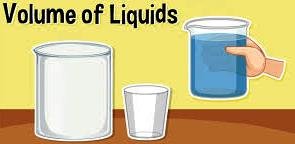Measuring volume of liquids is usually done using containers that have known volumes. Liquids takes the shapes of the container but have fixed volume. Hence apparatus has been devices to measure conveniently and precisely volume of a liquid.
This article describes the idea behind calibration of measuring cylinders and discuss some important apparatus used to measure volume. They apparatus includes:
- Measuring Cylinder
- Volumetric flasks
- beakers
- pipettes
- burettes
- user customized apparatus
Introduction Measuring Volume of liquids
one thing to note when Measuring volume of liquids is that liquids have no definite shape but assumes the shape of the containers in which they are put in.
One technique to measure the volume of a liquid is to pour it into a container of uniform cross-section. This is illustrated in the figure below.

The volume of the liquid is obtained from the formula:
Volume = cross-section area x height
i.e. V = Ah
For the diagram above, area of the cross-section is given as l x b.
This is because the cross-section area of the prism is a rectangle.
The liquid occupies space in the container like a rectangular prism. Thus, the volume of the liquid can be determined. Using the above diagram, the volume of the liquid in the container = l x b x h=lbh
Relationship between volume and height of a liquid column
If the area of a container is not changing, an increase in the liquid’s volume will raise the liquid column.
In the next, we investigate the change how change of liquid height is affected by volume.
Apparatus
- Rectangular container
- A cylinder
procedure
- Take two containers. P with a rectangular base and Q with a cylindrical base.
- Container Q is uniformly calibrated as in figure below

- pour some water into P and find it’s volume V.
- Transfer the water from P to Q and record the height h of water in Q.
- Repeat the above procedures for different values of V and record corresponding values of h as in the table below.
| Volume V(cm3) | 150 | 200 | 300 | 400 | 500 | 600 | 800 |
| height h(cm) | 0.97 | 1.30 | 1.95 | 2.60 | 2.35 | 3.90 | 5.20 |
| (v/h)cm2 | 154.64 | 153.84 | 153.85 | 153.85 | 153.85 | 153.85 | 153.85 |
a table for Volume against height of a liquid in a uniform container
- Draw the graph of V against h

In practice, measuring vessels are made in cylindrical form. Their height is calibrated uniformly. Each level of height represents the volume. The bottom surface area is fixed and cannot change.
Increase in height shows increase in volume and so the volume that is represented by a particular height can be conveniently indicated on each level of height so that it can always be read off directly without using the formulae;
V=BaseArea X height.
Measuring Instruments marked as described above are called measuring cylinders and are commonly used in measuring liquid volumes.
Measuring cylinders are usually made of glass or transparent plastic and graduated in cm3 or milliliters(ml).

other instruments that can be used to measure volumes includes:
- Measuring flasks
- pipettes
- burettes
- beakers
Measuring volume of liquids: Measuring flasks
Also known as volumetric flasks. It is commonly used in laboratories to transfer known volumes of liquids.
A volumetric flask is usually calibrated to contain a precise volume at a certain temperature. It is used for precise dilutions and preparation of standard solutions. These flasks are usually pear-shaped, with a flat bottom, and made of glass or plastic.

Measuring Volume of liquids with pipette
A pipette is usually used to transport a measured volume of liquid.
It’s name comes from the word pipe because it has a pipe like shape. Mostly it transfers liquids of less than 250ml in volume.

Burettes
A burette is a long graduated glass tube with a tap at the lower end. It has a fixed capacity. It also features a tapered capillary tube at the tap’s outlet. Typical burettes range from 50ml to 500ml in capacity.
The stop-cock valve manages the liquid flow from the burette. This ensures that a precise amount of liquid is delivered at any given moment.

The scale of a burette starts from zero at the top and increases downward to the maximum value.
In the diagram above, volume marking markings reads 20 ml. This means 20ml of the liquid has been removed from the burette. The volume left is (50-20)ml = 30ml.
Beaker
A beaker is a cylindrical container with flat bottom. It usually have a small spout (beak) to aid pouring.
Beakers are of various capacities and the largest can carry several litres of liquid.
Unlike a volumetric flask, beaker have a straight curved surface as opposed to sloping sides.

Beakers are usually made of glass (borosilicate glass). They can also be made in metal, such as stainless steel or aluminum. Certain plastics, notably polythene or polypropylene, are also used.
Beakers are common lab apparatus.
How to use a measuring cylinder and beaker
When reading volumes, position your eye with the bottom of the meniscus. Refer to the figure below.

Conclusion
In this article, we have described various instruments used to measure volumes and highlighted their special features . We have described how to calibrated a measuring cylinder using principles of regular prism. we have discussed some apparatus like beaker, volumetric flasks, pipette and burettes.
Related posts
- Physical Quantities
- Length
- Easy Integration4: partial fractions
- Reading a meter rule
- Measuring with a meter rule
- Area
- Area of irregularly shaped surfaces
- Volume
- Volume of regularly shaped objects
- Measuring volume of liquids
- Volume of irregular solids
- Measuring Mass
- Density
- Densities of some substances
- Questions on Measurements


Leave a Reply